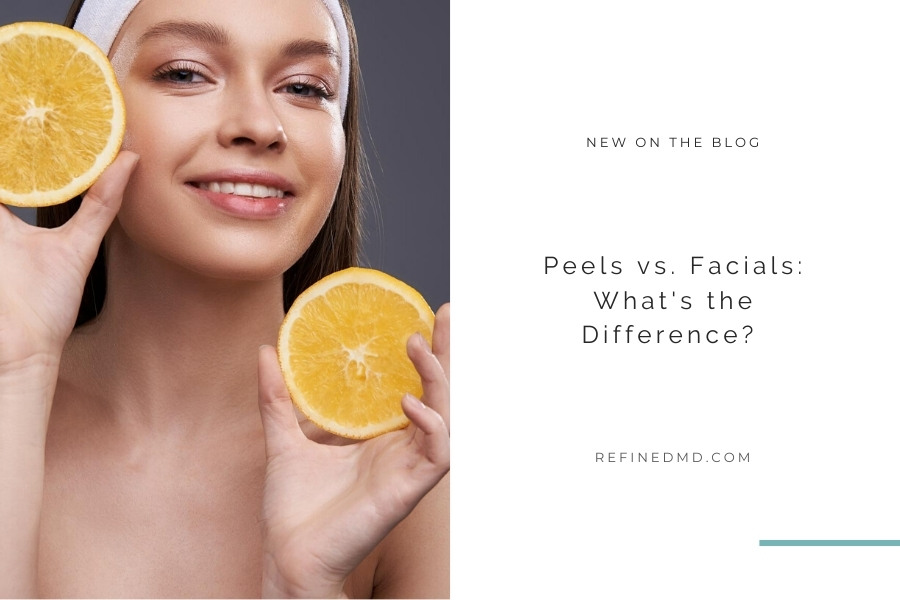
04 Aug Peels vs. Facials: What’s the Difference?
What’s the difference between a peel and a facial? At RefinedMD, we’ve found that many clients use the terms interchangeably, but that isn’t technically correct. Yes, both of these non-invasive procedures require the treatment be applied to the full face (and/or other areas, such as the neck, chest, tops of the hands as preferred) but they do completely different things. However, the benefits of a peel can be enhanced by a facial after healing, so really these two are a perfect pairing. The difference can be found in the names.
A chemical peel, sometimes shortened to just a “peel,” literally peels the top layer or layers of skin away in most cases. Peels come in light/superficial, medium, and deep depths. The vast majority of clients require a light or medium peel, which is why that is all that we offer in our clinic. There are some cases where a client may not obviously “peel” with a light chemical peel, but if that happens rest assured it is still doing its job. There are many options within the world of peels, and we are committed to providing you with several top-rated options.
Who Needs a Chemical Peel?
For many years, only those with fairer skin were good candidates for a chemical peel—but fortunately, those days are behind us! This was the case when peels had a high possibility of causing hypopigmentation, or unwanted lightening of the skin. Now, there are peels available for all skin tones and types. Every chemical peel is exactly what it sounds like: a concoction of chemicals (and often other ingredients) designed to peel away skin. But why?
The top layer of skin often harbors superficial imperfections like light lines, sun damage, and dullness or light scarring. When you remove that top layer, it reveals younger-looking, clearer, more beautiful skin below the surface. That’s one benefit of a peel, but it also works as a collagen induction therapy. When the skin is damaged in a controlled manner (like via a peel), it tells the body to start producing a lot of collagen in the treated area. This is why a peel typically looks better and better in the weeks following the treatment.
It is very important to follow your provider’s pre- and post-peel care instructions, especially when it comes to not picking at the peeling skin and using sunscreen. It is best if you can avoid direct sunlight for at least two weeks after a peel, particularly for medium-depth peels. Your younger-looking skin is newer and more vulnerable to UV damage. A chemical peel is also a fantastic time to commit or recommit to wearing medical-grade sunscreen any time you are exposed to UV rays (including by windows or while in a car) and re-applying every 75 minutes.
About Facials
A “facial” is a cocktail of ingredients designed to infuse the skin with the nutrients it needs to be better, brighter, clearer, and younger-looking. There is no peeling or controlled damage with a facial. Rather, the results are immediate and often continue improving for a day or two post-treatment. There are several different kinds of facials for men and women that can be used with all skin tones and types. We’ll work together to determine the best facial for you in order to get top results.
Following up a chemical peel with a facial is a great way to maximize results, and this can often be done around two weeks after a peel. You can also marry a facial with microneedling. Microneedling creates micro-channels (also called micro traumas) in the skin as a form of collagen induction therapy. However, it also opens the skin up so it can best receive the topicals that are applied during a facial. Microneedling can be beneficial with a facial, but is usually considered an ongoing treatment, too. Most people get a microneedling treatment every month.
Are you ready to take your skin to the next level? Schedule a consultation or appointment for a chemical peel, facial, or other cosmetic treatment today. Get in touch with RefinedMD by calling the office or fill out the online contact form.
